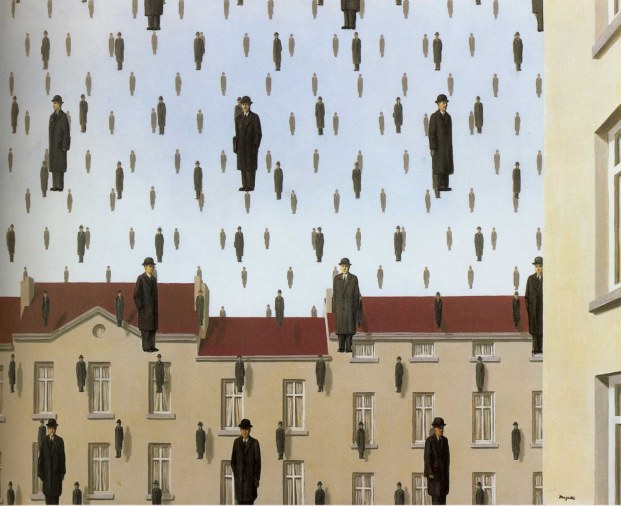Les Vacances de Hegel (Hegel’s Holiday), René Magritte, 1958
ICH BETE WIEDER, DU ERLAUCHTER
Ich bete wieder, du Erlauchter,
du hörst mich wieder durch den Wind,
weil meine Tiefen nie gebrauchter
rauschender Worte mächtig sind.
Ich war zerstreut; an Widersacher
in Stücken war verteilt mein Ich.
O Gott, mich lachten alle Lacher,
und alle Trinker tranken mich
__________________________
I pray again, you Illustrious One;
do you hear me again through the wind
because from my unused depths
mighty words are rushing.
I was dispersed; to the adversary
my self was given in pieces.
O God, I laughed all laughter,
and all drunkards drank me.
 Le clef des champs (The Key to the Fields) , 1936
Le clef des champs (The Key to the Fields) , 1936
Ich war ein Haus nach einem Brand,
darin nur Mörder manchmal schlafen,
eh ihre hungerigen Strafen
sie weiterjagen in das Land;
ich war wie eine Stadt am Meer,
wenn eine Seuche sie bedrängte,
die sich wie eine Leiche schwer
den Kindern in die Hände hängte.
__________________________
I was a house after a fire,
where only murderers sometimes sleep,
and their hungry punishments
pursue them through the land;
I was like a city on the sea,
pressed by a plague,
which like a heavy corpse
hung the children in the hands.
 Not to be Reproduced (La reproduction interdite), a portrait of Edward James by René Magritte, 1937
Not to be Reproduced (La reproduction interdite), a portrait of Edward James by René Magritte, 1937
Ich war mir fremd wie irgendwer
und wußte nur von ihm, daß er
einst meine junge Mutter kränkte,
als sie mich trug,
und daß ihr Herz, das eingeengte,
sehr schmerzhaft an mein Keimen schlug.
__________________________
I was a stranger to myself as one
of whom I knew only that he
once offended my young mother
as she carried me
and that her heart, thus constricted,
throbbed achingly about my sprouting self.
Jetzt bin ich wieder aufgebaut
aus allen Stücken meiner Schande
und sehne mich nach einem Bande,
nach einem einigen Verstande,
der mich wie ein Ding überschaut, –
nach deines Herzens großen Händen –
(o kämen sie doch auf mich zu)ich zähle mich, mein Gott, und du,
du hast das Recht, mich zu verschwenden.
__________________________
Now I am rebuilt
from all the pieces of my shame
and yearn for a bond,
for a unified understanding,
which regards me as one thing
– as I yearn for the big hands of your Heart [to
me]
(oh, let them draw near me)
I count myself, my God, and you,
You have the right, to waste me.
Rainer Maria Rilke
From The Book of Hours
Translation by Anita Barrows and Joanna Macy











































